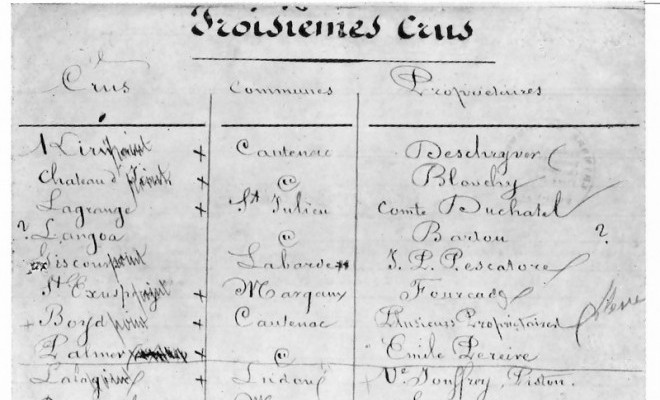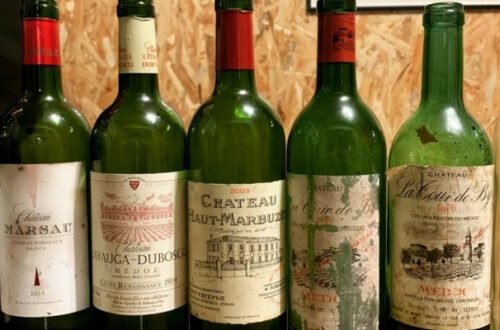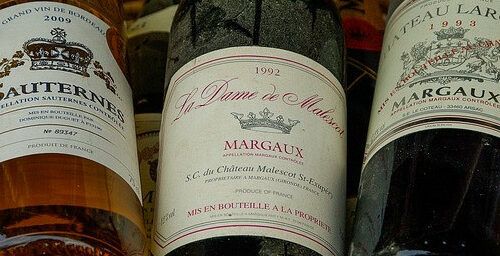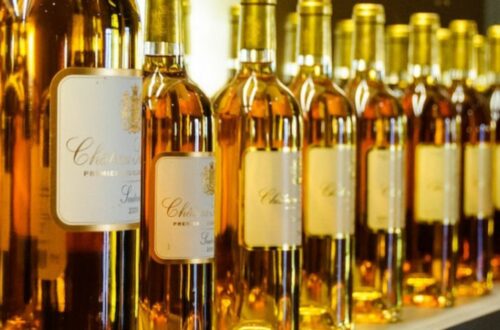
What is 3e cru classé in Bordeaux?
Bordeaux is known for its prestigious wines and the cosmic prices that go with it. However, some of these prestigious wines are still affordable by some of us. You have to be willing to put in hundreds (and not thousands) of euros, but for an occasion, some are willing to do so.
The third growth Bordeaux wines are usually under 500e euros a bottle. In French, they are called “3e cru classé”. In order to drink such bottles, let’s try to understand what “3e cru classé” really means.
What is a 3e cru classé in Bordeaux?
What is a cru?
The CONCEPT of Cru (Growth) is used to designate a specific vineyard, often a TERROIR or the name of a COMMUNE. A cru is the “winemaker” version of the denomination. To take the same example as my post on denominations: Margaux appellation is a cru of Bordeaux.
The territory can be a locality, a municipality or a wine estate.
The right to the “Cru” name is open under 3 conditions : that the product can be individualized, that it really and exclusively comes from the area it claims and, last but not least, that it belongs to an AOP.
A CRU is therefore associated with an AOC (for example the ten “Cru du (AOC) Beaujolais”), a geographical delimitation (a plot for areas such as Burgundy) or a communal delimitation (associated with the commercial value of the grapes and the grape variety), a farm (such as Saint-Emilion, whose Crus are updated every ten years), special production conditions (for example : Banyuls Grand Cru, which has a majority of Grenache and long aging)
However, in Bordeaux, the classification system is not linked to that of appellations, except in Saint-Emilion. Moreover, it does not concern specific terroirs, but estates (or castles as they are called in Bordeaux). Indeed, the size of the property can vary over the years, with the purchase or sale of plots. The name of a chateau is therefore more of a brand than the designation of a specific vineyard.
The classification of 1855
In 1855, Paris hosted the third UNIVERSAL Exhibition. For this occasion, Napoleon III asked his ministers to contact the Chambers of Commerce and Industry of the candidate REGIONS for the exhibition to encourage them to present their best products there by classifying them.
The President of the Chamber of Commerce and Industry, through wine brokers, in Bordeaux decided to respond to this request by establishing a classification of Bordeaux wines. But, wait! This only applies to the LEFT Bank of Bordeaux.
The red wines all come from Médoc, except Château Haut-Brion who belongs to the Pessac Léognan appellation.

The white wines come from Sauternes or Barsac.
The criteria for this classification was the following :
- the vine root depth and the ages of the vines. This influenced the length of aromas and the body of the wine
- the vineyard elevation and the degree of natural light the grapes get
- the terroir
- the quoted value on the market.
Originally, the list included 58 châteaux. Over time, this list has evolved and now includes 61 châteaux : 5 Premier Crus (First Growth), 14 Second Crus (Second Growth), 14 Third Crus (Third Growth), 10 Fourth Crus (Fourth Growth) and 18 Fifth Crus (Fifth Growth)
This list was revised only once in 1973, when Château Mouton Rothschild was promoted from Second Growth to First Growth.
Concerning the white wines, 27 sweet wines were classified from Sauternes and Barsac. Château d’Yquem is the only Premier Cru Supérieur, 11 Châteaux constitute the Premier Cru and 15 the Second Cru.
Over the years, the number, size and owners of classified châteaux have changed a lot, as has the quality of their wines. The relevance of the 1855 ranking to current quality levels is the subject of ongoing debate.
The list of the Third Growth (3e cru classé) is the following. Most of them belong to the Margaux appellation. Two are Saint-Julien and one is Haut-Médoc
- Château KIRWAN – Margaux is a blend from Cabernet Sauvignon, Merlot, Cabernet Franc and Petit Verdot. Depending on the vintages, some Carmenère may be added, in very small proportion, to the blend. It is a wine produced from the best plots, mainly gravelly (ideal for Cabernet Sauvignon) but also clayey (ideal for Merlot). Harvesting and double-sorting are done manually and vinification is done separately according to the plots. The wine is aged in oak barrels for 18 months and the latter are renewed by half every year.
- Château d’ISSAN – Margaux’s wine come from old vines of the Château d’Issan enclosure, located in the heart of the Margaux appellation. The terroir is mainly composted of gravel on the surface and clay in depth offering optimal maturity and freshness of the two grape varieties : Cabernet Sauvignon and Merlot. Expressing the exquisite bouquet specific to the Margaux region, it is distinguished by its suppleness, finesse, elegance and longevity specific to this terroir. The wines are aged in barrels for 16 to 18 months, 50% of which is new oak.
- Château LAGRANGE – Saint-Julien is a blend of Cabernet Sauvignon, Merlot and Petit Verdot. The grape varieties are vinified separately and the aging is done in oak barrels for 21 months, half of it being new oak. Located in the commune of Saint-Julien, the vineyard of Château Lagrange extends over 118ha of red vines planted on two gravel hilltops, oriented north-south. The estate has a clay-limestone subsoil, a silico-gravelly soil.
- Château LANGOA BARTON – Saint-Julien is a blend of Cabernet Sauvignon, Merlot and Cabernet Franc. The aging is done in oak barrels, 60% of which are new oak barrels.
- Château GISCOURS – Margaux’s first wine was a blend of 60% Merlot. Since 1995, due to climate and oenological choice, the blends are now Cabernet Sauvignon dominated and the Merlot is reduced to 20%. The wine ages in oak barrels for 16 to 18 months before blending.
- Château MALESCOT SAINT-EXUPÉRY – Margaux is a blend of Cabernet Sauvignon, Merlot, Cabernet Franc and Petit Verdot
- Château BOYD-CANTENAC – Margaux
- Château CANTENAC BROWN – Margaux is a blend from Cabernet Sauvignon and Merlot. The aging is done in oak barrels, 60% of which are new.
- Château PALMER – Margaux is a blend of Cabernet Sauvignon, Merlot and Petit Verdot
- Château LA LAGUNE – Haut-Médoc
- Château DESMIRAIL – Margaux is a blend of Cabernet Sauvignon, Merlot and Petit Verdot.
- Château CALON SÉGUR – Saint-Estèphe is a blend of Cabernet Sauvignon, Merlot, Cabernet Franc and Petit Verdot grown on a thick layer of gravel deposited by the river of the Quaternary, on a tertiary-age clay-dominant basement. At the top of the gravel deposits, there is also a fine level of clay of lacustrine origin. The vinification is done in new oak barrels.
ANECDOTE : Château Calon Ségur is Johnny’s Depp favorite wine, according to an interview with Oliver Styles from Madame Figaro: “It’s a marvelous wine you can drink every day and it’s also very affordable” (well, perhaps for you dear Johnny, but unfortunately, this isn’t the case for everyone…) He also enjoys Cheval Blanc, Petrus and Domaine de la Romanée Conti in Burgundy.
- Château FERRIÈRE – Margaux is a blend of Cabernet Sauvignon, Merlot, Cabernet Franc and Petit Verdot grown on deep gravel on limestone marl.
The aging is done in oak barrels for 18 months, 40% of which are new
- Château MARQUIS d’ALESME BECKER – Margaux is a blend of Cabernet Sauvignon, Merlot, Cabernet Franc and Petit Verdot grown on soils made of clay-limestone, clay gravel and siliceous gravel, with a natural gentle slope, ideally exposed.
Other classifications
The other classifications you may come across are the classification of Saint-Emilion in 1955 or the classification of Graves in 1953.
The classification of Saint-Emilion took place ten years later after the 1855 classification by INAO (Institut National de l’Origine et de la Qualité) and the ministries of Agriculture and Consumer and Commercial Relations on request of the Saint-Emilion appellation defense union.
This classification was done upon the following criteria :
- tasting of the wines,
- terroir
- renown of the Châteaux
82 châteaux were classified in Premier Grands Crus Classés, itself divided into A and B, and Grand Cru Classé.
Be careful, there is also a Saint-Emilion Grand Cru appellation : this regroups producers within a clearly defined appellation zone which meet specific requirements.
The Graves classification took place two years before in 1953, by INAO as well, on the request of the Graves appellation defense union.
16 châteaux were classified as Grand Cru Classé de Graves. All château belong to the appellation Pessac-Léognan.
This classification was created to complete the 1855 Classification.
All in all, depending on the budget you have of course, these 3rd Growth Wines are affordable and can be enjoyed by most, if you are willing to put a few hundred of euros in the bottle. I still believe that a bottle over a hundred euros is merely speculation but why not, for once, enjoy one of these famous bottles.
Would you do it? Let me know in the comments!






2 Comments
KellyAnn
I like the thought behind this article, but you ask in the end, would you do it? Would I do what… Would i try this wine, YES! I like how you broke the styles down and classified them where they belong. I struggle what “what I like” so I think this article would help narrow that down for me. Thank you for sharing.
Mademoiselle
Hello KellyAnn! Thank you for stopping by! My question was : would you put hundred of euros in a bottle if it’s a 3e cru, just to taste it.
otherwise, I’m glad it helped.